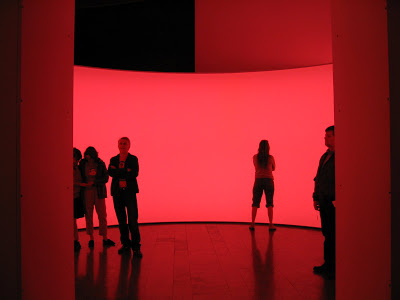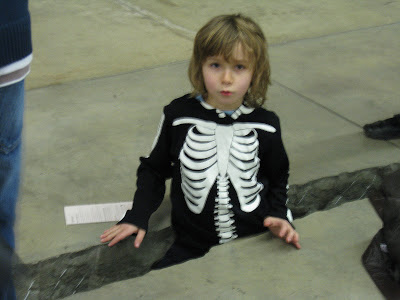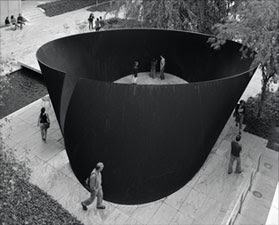Artists' Statements
Art Vent Letting the Fresh Air In
April 17, 2008

“The rainbow I see is not the rainbow you see”—rants about museum wall text and artists' statements come from a strong belief, derived initially from my study of Robert Irwin and his work, in the experience of art being unmediated and individual--that art which truly fulfills its purpose as art, requires no explanation. Olafur Eliasson, who I have also written about extensively, follows in Irwin’s footsteps and takes it one step further, viewing everything--from the publicity around an exhibition and the expectations it raises, to whatever personal interactions occur in the museum as well as the physical situation itself (including temperature, sound, and the presence of other people)--as contributing to the experience of the art. As he said yesterday at the press preview for his mid-career survey, which opens Sunday at MoMA and PS1: “I don’t want to interpret the work for you. My interpretation is not your interpretation.”
His pieces are not accompanied by wall text.
His pieces are not accompanied by wall text.
Comments (6)
February 25, 2008

The installation at the Tate Modern (below), Doris Salcedo’s Shibboleth provides an excellent example of rhetoric standing in for, or justifying, the art. This is excerpted from the publicity material, which I suggest reading in toto just to get the full effect:
Salcedo is addressing a long legacy of racism and colonialism that underlies the modern world…” The history of racism,” Salcedo writes, “runs parallel to the history of modernity, and is its untold dark side”…. Our own time, Salcedo is keen to remind us, remains defined by the existence of a huge socially excluded underclass, in Western as well as post-colonial societies…”
Hullo, it’s a crack. A crack. A break in concrete. The artist’s intention does not change the experience, which happens to be one that leads to strange parental behavior. But if you insist on metaphor, it could represent any disparity—including the one between those who are willing to shell out $50 for a Duchamp T-shirt and those who aren’t.
February 19, 2008

Richard Serra from a video interview at MoMA on NewArtTV: “There isn’t any big paradigm shift. What happens is work comes out of work, and if the paradigm shift occurs, it’s because a problem leads to a different solution that you could not have anticipated.” Serra explains that he began his studio practice, not by plotting out specific pieces, but by asking himself questions such as: “What does it mean to build something that has a fixed joint?” “What does it mean to balance something?…to counterbalance something?” When asked by a journalist how he sees his future work at this point in his career, Serra repeats, “Work comes out of work. I don’t anticipate work to come….I just want to work.”
Ah, more support for my contention that art springs not from the “idea” or “concept” (see Back from VSC 2/1 and Talking the talk or…2/3 and the discussion in the Comments) that so many students are encouraged to have in place before they begin, but from the work itself and the questions it raises. The danger is that a “concept” can easily become a closed circuit—with the work remaining simply an illustration of that concept—whereas a “question” is an open one. This is not to say that there’s no place for analysis, but it’s a different activity, not to be mistaken for the art.
At its best, art produces responses that can’t be quantified—that are sensed rather than understood. So if we’re after something that can’t be understood, or an answer we didn’t anticipate, intellect won’t help us, only intuition—and the work, our process, is the stage we set to allow intuition to unfold.
Similarly, when talking or writing about their work, artists often give so much information, or information extraneous to the experience, that it interferes with the reaction to it and cuts off the possibility of responses they may not have anticipated—you can torture yourself with examples of this also on NewArtTV such as Diana Thater saying, “My work is about, for the most part, learning and knowing through observation that observation is knowledge or intense observation produces knowledge….” Does that make you crazy to see her work or what?
This is why, when I’m king, along with abolishing the artists’ statement, I’ll also regulate wall text, which I’ve noticed museum visitors spend more time with than the work itself. It’s not that information about an exhibition shouldn’t exist, but best relegated to a special room near the exit, one to which visitors can only gain entrance after proving that they’ve actually looked at what’s on display by taking a short quiz.
February 3, 2008

It’s always gratifying to have one’s beliefs confirmed, especially by the likes of Jasper Johns. Following yesterday’s post and comments about the relative necessity of artists being able to articulate what their work means (I think that’s what critics are for—why do their job for them?) comes a piece in today's New York Times about the upcoming exhibition at the Met organized around his gray paintings, about which Johns says, “Yes, gray is important to me. But I don’t tend to think of it as separate from the rest of my work” and explains his relationship to the tradition of monochromatic painting by stating, “I was trying to do something else.” A good press release that does not make. I’ve met Johns and found him, as he’s known to be, distinctly unresponsive in conversation. But does that mean he's any less an artist? Sometimes people choose a visual means of expression because words are not their strong point. Johns’s reticence, however, may be seen as a matter of choice rather than the result of simple inhibition when, at the end of the article, he’s quoted as saying, “To me…self description is a calamity.” You can’t get more emphatic than that.
February 1, 2008
Visiting with 25 or so artists last week at the Vermont Studio Center, I found that part of my job there--besides eating as much bread, butter, and dessert as possible--was to poke holes in some closely-held art world tenets:
Artworks must be consistent for a final review, to show a dealer, or for an exhibition. “A foolish consistency is the hobgoblin of little minds,” said Ralph Waldo Emerson. I’m not sure where this reverence for sameness came from. Even though its usefulness has been flagrantly disproven by two of the most famous artists of our time, Louise Bourgeois and Gerhard Richter, it persists among young artists who are afraid to experiment because their job, as they see it, is to produce a “body of work” with a singular character. Sometimes I have to remind them that what looks like a big difference to the artist is negligible to the viewer, and that their work is unified simply by being theirs. But even if the leaps were huge, so what? While I’ve never been to an exhibition where observers complained that the work was too diverse, I’ve been to plenty where it was criticized for being too similar.
You have to have a concept in mind—and be able to articulate it—before you can start working. This belief stops many people from making art before they even begin. Ideas come from the process, not the other way around. It’s about starting somewhere, anywhere, and seeing where it leads. The starting point can be a concept, but as such it’s just another tool, a means to the end. If you know the outcome before you do the work, why bother?
After it’s finished, the artist should be able to explain what the work is about and why he/she did it. I have to admit that I had no idea what my work meant or could mean—to me or anyone—until I read the reviews. And while other people have contributed many interpretations, all of which feel valid, if you ask me what my current work is about I really have no clue. Where did it come from? I don’t know; it just happened. In his New York Times obituary Roy Lichtenstein was quoted as saying “I don’t think artists like myself have the faintest idea what we’re doing…”
When I’m king, along with regulating how early in the season stores can start flogging for Christmas and changing the term “ice pellets” back to “sleet,” I’m going to outlaw artist’s statements.
Artworks must be consistent for a final review, to show a dealer, or for an exhibition. “A foolish consistency is the hobgoblin of little minds,” said Ralph Waldo Emerson. I’m not sure where this reverence for sameness came from. Even though its usefulness has been flagrantly disproven by two of the most famous artists of our time, Louise Bourgeois and Gerhard Richter, it persists among young artists who are afraid to experiment because their job, as they see it, is to produce a “body of work” with a singular character. Sometimes I have to remind them that what looks like a big difference to the artist is negligible to the viewer, and that their work is unified simply by being theirs. But even if the leaps were huge, so what? While I’ve never been to an exhibition where observers complained that the work was too diverse, I’ve been to plenty where it was criticized for being too similar.
You have to have a concept in mind—and be able to articulate it—before you can start working. This belief stops many people from making art before they even begin. Ideas come from the process, not the other way around. It’s about starting somewhere, anywhere, and seeing where it leads. The starting point can be a concept, but as such it’s just another tool, a means to the end. If you know the outcome before you do the work, why bother?
After it’s finished, the artist should be able to explain what the work is about and why he/she did it. I have to admit that I had no idea what my work meant or could mean—to me or anyone—until I read the reviews. And while other people have contributed many interpretations, all of which feel valid, if you ask me what my current work is about I really have no clue. Where did it come from? I don’t know; it just happened. In his New York Times obituary Roy Lichtenstein was quoted as saying “I don’t think artists like myself have the faintest idea what we’re doing…”
When I’m king, along with regulating how early in the season stores can start flogging for Christmas and changing the term “ice pellets” back to “sleet,” I’m going to outlaw artist’s statements.